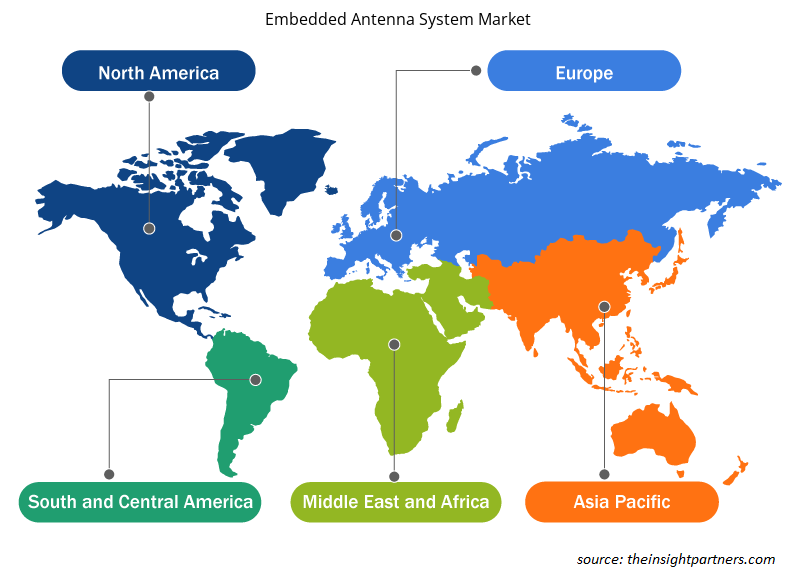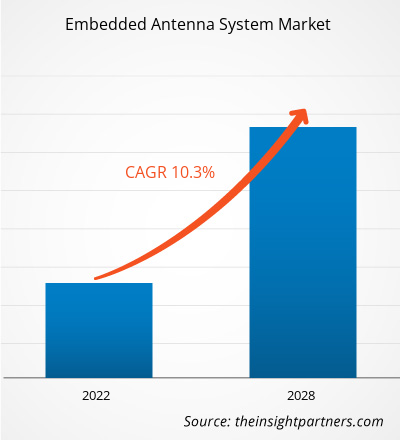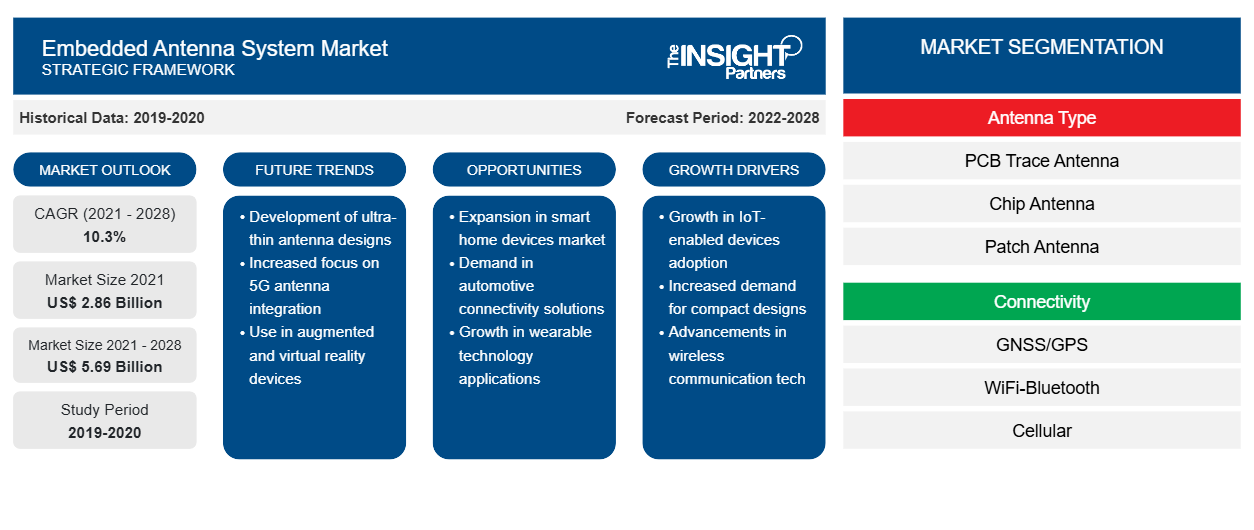Der Markt für eingebettete Antennensysteme soll von 2.858,37 Millionen US-Dollar im Jahr 2021 auf 5.685,63 Millionen US-Dollar im Jahr 2028 wachsen; von 2021 bis 2028 wird mit einer durchschnittlichen jährlichen Wachstumsrate von 10,3 % gerechnet.
Eine eingebettete Antenne verwendet Metamaterialien, um die Leistung kleiner Antennensysteme zu verbessern. Das eingebettete Antennensystem verwendet eine elektromagnetische Antenne, um Energie in den freien Raum zu erzeugen. Metamaterialien werden mit einzigartigen, typischerweise mikroskopischen Strukturen entwickelt, um unerwartete physikalische Eigenschaften zu erzeugen. Die zunehmende Verbreitung fortschrittlicher Technologien wie dem Internet der Dinge (IoT), 5G und künstlicher Intelligenz unterstützt das Wachstum des Marktes für eingebettete Antennensysteme. Die zunehmende Verwendung eingebetteter Systeme in IoT-Geräten, die wachsende Nachfrage nach intelligenten Antennen für die Fernarbeit im Gesundheitssektor, die zunehmende Verbreitung des Internets, der Anstieg der Zahl der Smartphone-Benutzer und die Fortschritte bei 5G-Technologien sind wichtige Triebkräfte für das Marktwachstum. Darüber hinaus wird erwartet, dass der wachsende Bedarf an eingebetteten Antennensystemen in Smart Homes, Smart Grids, vernetzten Automobilen, intelligenten Thermostaten usw. das Marktwachstum im gesamten Prognosezeitraum ankurbeln wird. Die zunehmende Verwendung von Unterhaltungselektronik wie Smartphones und Laptops in Industrie- und Entwicklungsländern ist hauptsächlich auf das steigende verfügbare Einkommen, die wachsende Bevölkerung und die zunehmende Internetdurchdringung zurückzuführen. Fortschritte bei Smartphone-Technologien und die zunehmende Digitalisierung sind weitere wichtige Faktoren, die das Wachstum des Marktes für eingebettete Antennensysteme vorantreiben.
Der Markt für eingebettete Antennensysteme ist nach Antennentyp, Konnektivität, Endverbrauch und Geografie segmentiert. Basierend auf dem Antennentyp ist der Markt in PCB-Spurantenne, Chipantenne, Patchantenne, flexible Leiterplattenantenne und andere segmentiert. Auf der Grundlage der Konnektivität ist der Markt in GNSS/GPS, WiFi-Bluetooth, Mobilfunk, mmWave (5G), LPWAn, RFID und UWB segmentiert. Basierend auf der Endnutzung ist der Markt für eingebettete Antennensysteme in Unterhaltungselektronik, Kommunikation, Gesundheitswesen, Luft- und Raumfahrt & Verteidigung, Industrie, Automobil & Transport und andere segmentiert. Basierend auf der Geografie ist die Gesamtgröße des Marktes für eingebettete Antennensysteme hauptsächlich in Nordamerika, Europa, Asien-Pazifik (APAC), Naher Osten & Afrika (MEA) und Südamerika unterteilt.
Airgain, Inc.; Antenova ltd.; Infinite Electronics International, inc.; Kyocera AVX Components Corporation; Mitsubishi Materials Corporation; MOLEX; LINX Technologies; TE Connectivity; Walsin Technology Corporation; YAGEO Group; TAOGLAS; Tallysman; Panorama Antennas ltd; Mobile Mark, inc.; und 2J Antennas SRO sind die Hauptakteure, die im Rahmen der Marktstudie für eingebettete Antennensysteme profiliert wurden. Darüber hinaus werden im Rahmen der Marktanalyse mehrere andere bedeutende Hersteller eingebetteter Antennensysteme analysiert und untersucht, um einen ganzheitlichen Überblick über den globalen Markt für eingebettete Antennensysteme und sein Ökosystem zu erhalten., Inc.; Antenova ltd.; Infinite Electronics International, inc.; Kyocera AVX Components Corporation; Mitsubishi Materials Corporation; MOLEX; LINX Technologies; TE Connectivity; Walsin Technology Corporation; YAGEO Group; TAOGLAS; Tallysman; Panorama Antennas ltd; Mobile Mark, inc.; and 2J Antennas S.R.O. are the key players profiled during the embedded antenna system market study. In addition, several other significant embedded antenna system makers are analyzed and studied during the course of market analysis to get a holistic view of the global embedded antenna system market and its ecosystem.
Passen Sie diesen Bericht Ihren Anforderungen an
Sie erhalten kostenlos individuelle Anpassungen an jedem Bericht, einschließlich Teilen dieses Berichts oder einer Analyse auf Länderebene, eines Excel-Datenpakets sowie tolle Angebote und Rabatte für Start-ups und Universitäten.
- Holen Sie sich die wichtigsten Markttrends aus diesem Bericht.Dieses KOSTENLOSE Beispiel umfasst eine Datenanalyse von Markttrends bis hin zu Schätzungen und Prognosen.
Auswirkungen der COVID-19-Pandemie auf den Markt für eingebettete Antennensysteme
Im Laufe der Jahre hat die Nutzung eingebetteter Antennensysteme branchenübergreifend stark zugenommen, um die Produktleistung zu verbessern und Designflexibilität zu bieten. Der Ausbruch der COVID-19-Pandemie brachte jedoch verschiedene Branchen, wie den industriellen Anlagenbau, die Automobil- und Transportbranche sowie die Unterhaltungselektronik, in Schwierigkeiten. Regierungen erließen unter anderem Reisebeschränkungen und soziale Distanzierungsmaßnahmen, um die Verbreitung des neuen Coronavirus einzudämmen, was im ersten und zweiten Quartal 2020 zur vorübergehenden Schließung von Produktionseinheiten führte. Mit der Normalisierung der Wirtschaftstätigkeit begannen die Produktionsanlagen jedoch im dritten Quartal 2020 wieder mit 50 % ihrer Kapazität zu arbeiten. Laut dem Statistischen Bundesamt für Europa war der Einzelhandel in der Region von den negativen Auswirkungen der Pandemie betroffen. Laut der Organisation verzeichnete Deutschland infolge der zweiten Welle des COVID-19-Ausbruchs im Februar 2021 einen Rückgang des gesamten Einzelhandelsumsatzes um 9 %. Dieser Rückgang führte zu einem geringeren Bedarf an POS-Systemen für den Einzelhandel, was die Nachfrage der POS-Systemhersteller nach eingebetteten Antennensystemen bremste. Mit sinkenden Infektionsraten, schnellen Impfkampagnen und staatlichen Initiativen zur Förderung der wirtschaftlichen Erholung konnten jedoch ab dem dritten Quartal 2020 in vielen Branchen die Arbeit wieder normal aufgenommen werden. Daher erholt sich der Markt für eingebettete Antennensysteme schnell, um die negativen Auswirkungen der COVID-19-Pandemie zu überwinden.POS systems, which hindered the demand for embedded antenna systems from the POS system manufacturers. However, with lowering infection rates, rapid vaccination drives, and government initiatives promoting economic recovery, various industries began operating normally from the Q3 of 2020. Thus, the embedded antenna systems market is reviving rapidly to overcome the negative effects caused by the COVID-19 pandemic.
Einblicke in den Markt für eingebettete Antennensysteme
Zunehmende Einführung eingebetteter Antennensysteme in der Unterhaltungselektronikbranche treibt Marktwachstum an
Geräte der Unterhaltungselektronik wie Smartphones, Laptops, Smart-TVs, Wearables, Tablets, Spielkonsolen und Peripheriegeräte verwenden eingebettete Antennensysteme für drahtlose Anwendungen, darunter Bluetooth, WLAN, Wi-Fi und GPS. Die zunehmende Nutzung von Smartphones und Laptops in Industrie- und Entwicklungsländern ist hauptsächlich auf das steigende verfügbare Einkommen, die wachsende Bevölkerung und die zunehmende Internetdurchdringung zurückzuführen. Fortschritte in der Smartphone-Technologie und die zunehmende Digitalisierung treiben das Wachstum des Marktes für eingebettete Antennensysteme voran. Darüber hinaus steigt mit der zunehmenden Popularität von Bluetooth auch die Nachfrage nach Headsets, Smartphones, Wearables, Spielkonsolen und anderen Unterhaltungselektronikgeräten, was zum Wachstum des Marktes für eingebettete Antennen beiträgt.
Die fortschreitenden technologischen Fortschritte haben in mehreren Volkswirtschaften zu einem Anstieg der Verbreitung von elektronischen Geräten für Verbraucher geführt. Laut der Consumer Technology Association (CTA) beliefen sich die Smartphone-Verkäufe in den USA im Jahr 2020 auf 152 Millionen Einheiten. Darüber hinaus stiegen die Smartphone-Lieferungen laut der International Data Corporation (IDC) im Jahresvergleich um 5,3 % und erreichten im Jahr 2021 1,35 Milliarden Einheiten.
Regionale Einblicke in den Markt für eingebettete Antennensysteme
Die regionalen Trends und Faktoren, die den Markt für eingebettete Antennensysteme im gesamten Prognosezeitraum beeinflussen, wurden von den Analysten von Insight Partners ausführlich erläutert. In diesem Abschnitt werden auch die Marktsegmente und die Geografie eingebetteter Antennensysteme in Nordamerika, Europa, im asiatisch-pazifischen Raum, im Nahen Osten und Afrika sowie in Süd- und Mittelamerika erörtert.

- Erhalten Sie regionalspezifische Daten zum Markt für eingebettete Antennensysteme
Umfang des Marktberichts zum eingebetteten Antennensystem
| Berichtsattribut | Details |
|---|---|
| Marktgröße im Jahr 2021 | 2,86 Milliarden US-Dollar |
| Marktgröße bis 2028 | 5,69 Milliarden US-Dollar |
| Globale CAGR (2021 - 2028) | 10,3 % |
| Historische Daten | 2019-2020 |
| Prognosezeitraum | 2022–2028 |
| Abgedeckte Segmente | Nach Antennentyp
|
| Abgedeckte Regionen und Länder | Nordamerika
|
| Marktführer und wichtige Unternehmensprofile |
|
Dichte der Marktteilnehmer für eingebettete Antennensysteme: Die Auswirkungen auf die Geschäftsdynamik verstehen
Der Markt für eingebettete Antennensysteme wächst rasant, angetrieben durch die steigende Nachfrage der Endnutzer aufgrund von Faktoren wie sich entwickelnden Verbraucherpräferenzen, technologischen Fortschritten und einem größeren Bewusstsein für die Vorteile des Produkts. Mit steigender Nachfrage erweitern Unternehmen ihr Angebot, entwickeln Innovationen, um die Bedürfnisse der Verbraucher zu erfüllen, und nutzen neue Trends, was das Marktwachstum weiter ankurbelt.
Die Marktteilnehmerdichte bezieht sich auf die Verteilung der Firmen oder Unternehmen, die in einem bestimmten Markt oder einer bestimmten Branche tätig sind. Sie gibt an, wie viele Wettbewerber (Marktteilnehmer) in einem bestimmten Marktraum im Verhältnis zu seiner Größe oder seinem gesamten Marktwert präsent sind.
Die wichtigsten auf dem Markt für eingebettete Antennensysteme tätigen Unternehmen sind:
- Airgain, Inc
- Antenova GmbH
- Infinite Electronics International, Inc.
- Kyocera AVX Components Corporation
- Mitsubishi Materials Corporation
Haftungsausschluss : Die oben aufgeführten Unternehmen sind nicht in einer bestimmten Reihenfolge aufgeführt.

- Überblick über die wichtigsten Akteure auf dem Markt für eingebettete Antennensysteme
Markteinblicke basierend auf Antennentypen
Basierend auf dem Antennentyp ist der Markt für eingebettete Antennensysteme in PCB-Spurantennen, Chipantennen, Patchantennen, flexible Leiterplattenantennen und andere unterteilt. Im Jahr 2020 hatte das Segment der PCB-Spurantennen den größten Marktanteil.
Endverbrauchsbasierte Markteinblicke
Basierend auf der Endnutzung ist der Markt für eingebettete Antennensysteme in Unterhaltungselektronik, Kommunikation, Gesundheitswesen, Luft- und Raumfahrt & Verteidigung, Industrie, Automobil & Transport und andere unterteilt. Im Jahr 2020 hatte das Segment Unterhaltungselektronik den größten Marktanteil.
Die Akteure auf dem Markt für eingebettete Antennensysteme verfolgen Strategien wie Fusionen, Übernahmen und Marktinitiativen, um ihre Position auf dem Markt zu behaupten. Nachfolgend sind einige Entwicklungen der wichtigsten Akteure aufgeführt:
- Im Januar 2022 stellte KYOCERA AVX auf der CES 2022 in Las Vegas die Evaluierungsplatine zum Testen der Antennenbandumschaltleistung vor.
- Im August 2021 unterzeichnete TE Connectivity TE eine endgültige Vereinbarung zur Übernahme des Antennengeschäfts von Laird Connectivity.
- Historische Analyse (2 Jahre), Basisjahr, Prognose (7 Jahre) mit CAGR
- PEST- und SWOT-Analyse
- Marktgröße Wert/Volumen – Global, Regional, Land
- Branchen- und Wettbewerbslandschaft
- Excel-Datensatz
Aktuelle Berichte
Verwandte Berichte
Erfahrungsberichte
Grund zum Kauf
- Fundierte Entscheidungsfindung
- Marktdynamik verstehen
- Wettbewerbsanalyse
- Kundeneinblicke
- Marktprognosen
- Risikominimierung
- Strategische Planung
- Investitionsbegründung
- Identifizierung neuer Märkte
- Verbesserung von Marketingstrategien
- Steigerung der Betriebseffizienz
- Anpassung an regulatorische Trends





















 Kostenlose Probe anfordern für - Markt für eingebettete Antennensysteme
Kostenlose Probe anfordern für - Markt für eingebettete Antennensysteme